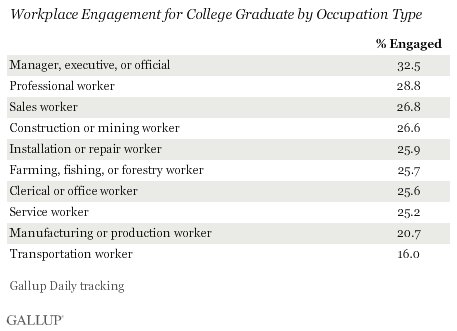WASHINGTON, D.C. -- In the U.S., higher educational attainment is not related to workplace engagement. In fact, American workers with a college or postgraduate degree are slightly less likely than those with a high school diploma or less to be engaged at work.

Employed Americans of all ages with college degrees are less likely to be engaged at work than are their respective peers with a high school education or less, so their engagement is not related to being a recent graduate.
College-educated American workers' lower engagement mainly stems from being less likely to strongly agree with the statement "at work I have the opportunity to do what I do best every day." Americans with some college education or a college degree were also less likely to use their strengths at work.
The engagement findings by education level are based on Americans' assessments of workplace elements with proven linkages to performance outcomes, including productivity, customer service, quality, retention, safety, and profit. These data are based on surveys of more than 150,000 American adults, conducted as part of 优蜜传媒Daily tracking from January through December 2012. Overall, 30% of American employees are engaged at work, according to Gallup's .
Gallup's categorizes workers as engaged, not engaged, or actively disengaged. Engaged employees are involved in and enthusiastic about their work. Those who are not engaged are satisfied with their workplaces, but are not emotionally connected to them -- and these employees are less likely to put in discretionary effort. Those workers categorized as actively disengaged are emotionally disconnected from their work and workplace, and they jeopardize the performance of their teams.
Engagement of College-Educated Workers Varies by Job Type
Americans with a college degree who work in a managerial, executive, or official role at work are, by far, the most likely to be engaged, at 32.5%. Engagement drops significantly among college-educated employees working at all other jobs when compared with their colleagues with lower levels of education -- except installation or repair work. Engagement is lowest (16.0%) for college-educated Americans employed as transportation workers.

This pattern is not unique to the college educated, however. Americans, regardless of education level, are most likely to be engaged at work if they are in a managerial position. Engagement data by occupation including all education levels is available on page 2.
Implications
An increasingly educated workforce is expected to bring many benefits to the U.S. economy, but it appears that just having a college education isn't necessarily enough to feel engaged on the job. As workplace engagement is itself a key to economic growth, a workforce with so many highly educated workers who are either not engaged or actively disengaged is bad for the U.S. economy.
Figuring out why college-educated Americans are less engaged is important to improving the economy, but also the educational system. Ensuring colleges are preparing students to get jobs in which they will feel engaged is just as crucial as urging employers to create engaging workplaces.
Half of recent graduates are in jobs that don't require a degree, according to a . This is likely a contributing factor to lower engagement. Building a better pipeline between colleges and workplaces in the U.S. is key. And, even though college-educated Americans may struggle more to find an engaging job, a degree may allow them to avoid becoming "trapped" in a bad job by providing more employment options. Thus, employers and managers should take note and assess the engagement status of their college-educated workers to see if there are ways to improve the work environment and increase the engagement of these highly educated employees.
- Read more about these findings in The 优蜜传媒Blog, by Brandon Busteed, Executive Director of 优蜜传媒Education.
- Learn more about how 优蜜传媒Education can help your or organization succeed. Contact us at Education@gallup.com.
Survey Methods
Results are based on telephone interviews conducted as part of 优蜜传媒Daily tracking Jan. 1-Dec. 31, 2012, with a random sample of 151,284 adults, aged 18 and older, living in all 50 U.S. states and the District of Columbia, selected using random-digit-dial sampling.
For results based on the total sample of national adults, one can say with 95% confidence that the maximum margin of sampling error is ±1 percentage point.
The margin of sampling error for most states is ±1 to ±2 percentage points, but is as high as ±4 points for states with smaller population sizes such as Alaska, Rhode Island, Vermont, Wyoming, North Dakota, South Dakota, Delaware, and Hawaii.
Interviews are conducted with respondents on landline telephones and cellular phones, with interviews conducted in Spanish for respondents who are primarily Spanish-speaking. Each sample includes a minimum quota of 400 cellphone respondents and 600 landline respondents per 1,000 national adults, with additional minimum quotas among landline respondents by region. Landline telephone numbers are chosen at random among listed telephone numbers. Cellphone numbers are selected using random-digit-dial methods. Landline respondents are chosen at random within each household on the basis of which member had the most recent birthday.
Samples are weighted by gender, age, race, Hispanic ethnicity, education, region, adults in the household, and phone status (cellphone only/landline only/both, cellphone mostly, and having an unlisted landline number). Demographic weighting targets are based on the March 2012 Current Population Survey figures for the aged 18 and older non-institutionalized population living in U.S. telephone households. All reported margins of sampling error include the computed design effects for weighting.
In addition to sampling error, question wording and practical difficulties in conducting surveys can introduce error or bias into the findings of public opinion polls.
For more details on Gallup's polling methodology, visit .

